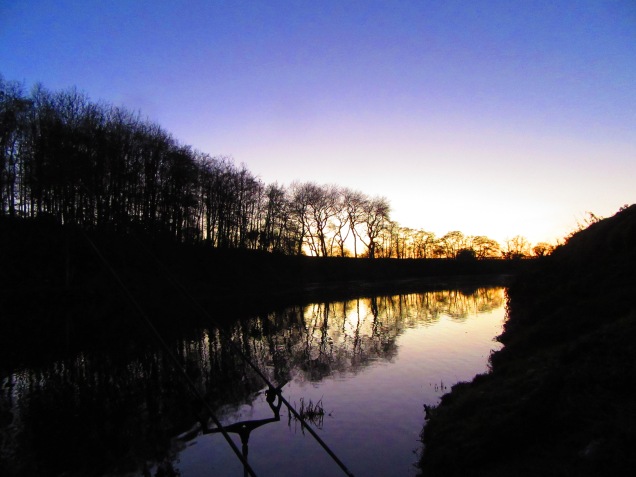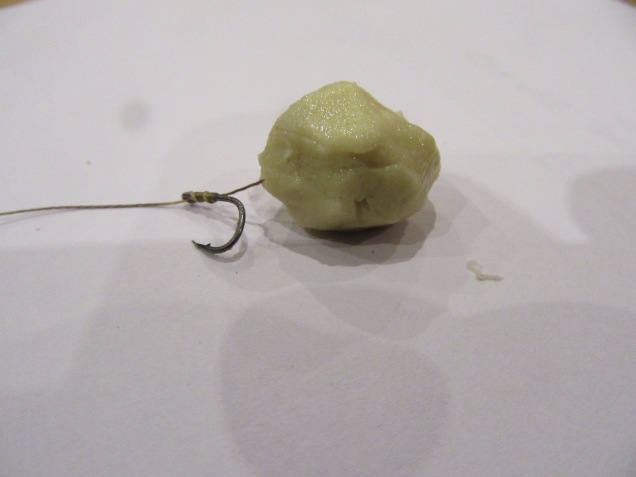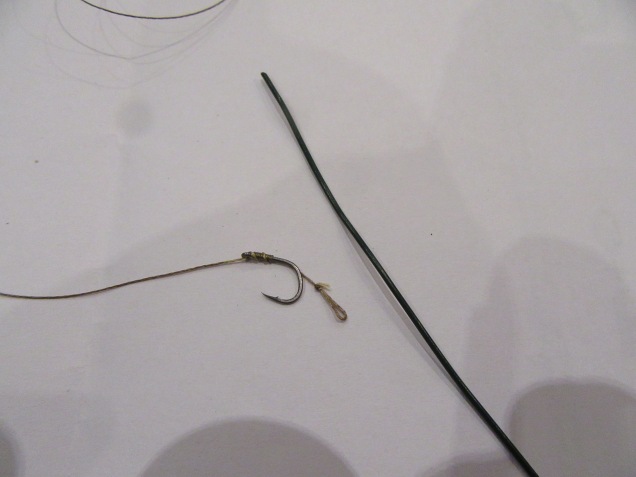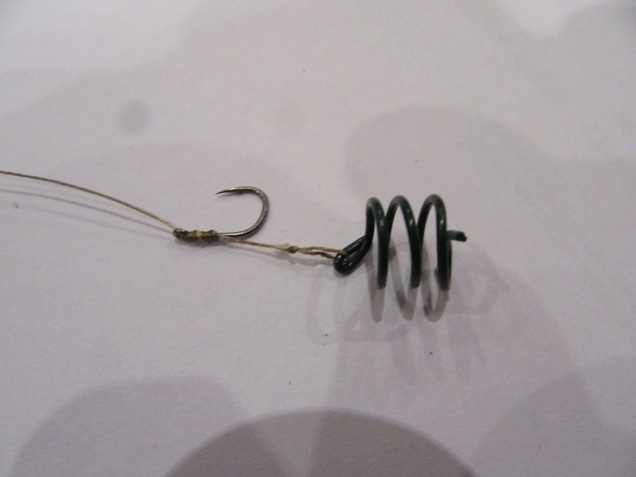
It is the end of November as I write this, and I am looking out of my window onto a bright sunlit day with an air temperature of just 3C. The early part of the month brought some sleety showers over the North West; that icy cold water made its way inexorably into the local waterways, bringing with it melted road salt currently being spread liberally on our roads. However, a dry frosty period is now set in for the remainder of the month.
One might be forgiven for thinking river fishing would be a complete waste of time given the conditions and the plummeting water temperatures, but as the Barbel become much harder to catch the ever reliable and obligingly sporting Chub steps up to the mark.
I still consider myself an enthusiastic amateur when it comes to chub fishing, but I look forward to the approach of winter when I can pick up my Chub rod and a ball of stinking cheesepaste and head for the river. I have spent time refining my recipe and my approach to using it, but it’s still a work in progress, so with your indulgence I will combine a bit about this fine bait with the usual fishing report.
Bread and Cheese
Two of the best baits for the wonderful Chevin are the readily available (and relatively cheap) staples of bread and cheese. Cheese is commonly fished in the form of a paste and this is how I make and use it.
Keeping it Traditional
I have 2 recipes for Cheesepaste, the first is a common standard you will see quoted time and again in angling books and forums. The measurements may vary slightly but they are all around this specification;
8oz Blue cheese (any type as smelly as possible).
8oz strong cheddar (Extra mature or cooking cheddar).
8oz Berol shortcrust pastry (frozen).
Glug of oil (hemp or vegetable)
Method
Defrost the pastry (not in the microwave, it cooks it!!)
Flake the blue cheese into a large bowl
Grate the cheddar into the bowl
Add the defrosted pastry
Add glug of oil
Knead into a paste.
Keep going until ALL lumps are gone, takes a bit of time and effort but it will be worth it, and a better bait for reasons to be revealed later.
And that’s about it, simple! That will give you a pound and a half which will last you practically all winter. Break into 4oz balls and freeze. Never throw any away no matter how smelly it gets, the stronger the better as far as Chub are concerned. I usually leave mine to mature (fester!) for a few days before I use it anyway.
So Why Change a winning recipe?
You may be wondering why anybody would go to the trouble of tampering with the traditional recipe that is proven and has caught so many fish. Well, I believe there are 2 fundamental drawbacks with cheese paste;
- The high fat content causes the paste to harden when its temperature is reduced, ie when dropped into an icy cold river. If used directly on the hook it can mask the point and prevent bites turning into hooked fish.
- Again because of the high fat content, flavour leakage into the water is reduced at low temperature. Winter conditions are often murky and we rely on the scent trail and small particle’s coming from our baits to entice the fish to find them.
OK, so we know that the high fat content is causing some problems, but is it not also the thing that makes cheesepaste such an effective bait? I am very reluctant to change a legendary and proven bait too much, but in an effort to slightly reduce the fat and to help with flavour leakage I have recently experimented with replacing the pastry element in the above recipe with some milk protein basemix from the hookbait company. This includes a gelatine based flavour bottle and has a nice cheesy/creamy/vanilla smell and the whole product goes by the name of ‘Big Cheese’.
http://hookbaits.com/wp/?page_id=943
One of the selling points of this product is to reduce the fat content of the finished paste by replacing the pastry. I’m no food scientist but when you look at the fat content of typical ready-made uncooked shortcrust pastry it comes out around 22%, and when you consider the fat content of the two cheeses is 29% for the blue, 33% for cheddar, it can only make a small impact. However the gelatine should be beneficial in preventing hardening and assisting flavour leakage. There doesn’t seem to be much of it in the basic recipe though, so I add a glug of hemp oil as well to get a very supple mix. When dropped into cold water it hardens just a little but nowhere near as much as the traditional recipe.
My initial trials have been quite promising, the flavour must still be there as I have caught a few, and I have been able to fish the paste directly on the hook quite successfully. As for scent leakage I have no idea if it’s any better than the original to be honest, a lot more fishing will have to be done!
Alternative methods
Rather than tamper with the actual bait there are other alternative tactical changes that can overcome these little niggles. After a fair bit of trial and error I often try some of the following ideas, each of which might provide a solution on a given day;
Hair rig
The first is simply not to use the cheesepaste directly on the hook. Tie up a hooklength with a fairly short hair and attach a small piece of Zig foam or a cork ball. Wrap the paste around this and you have a decent way of fishing the bait that doesn’t mask the hook, plus the buoyancy of the foam or cork helps to neutralise the weight of the hook and give a more natural bait presentation.


Another alternative is to use a paste coil on the hair. These are commercially available but I find some of them a bit flimsy and they often get ripped off when in the net with an angry Chub. A cheap alternative is to make a simple coil on the bank using garden wire. Just fix a length of wire to the hair then wind it round a disgorger or similar. Its surprising how well this will hang on to a ball of paste, I regularly cast to far bank swims on the Ribble maybe 40m and the ball stays exactly where it should, plus the added bonus that it costs next to nothing.





Unfortunately, even these solutions have their short-comings as chub are masters of wrenching the rod off its rests without getting hooked when fishing hair rigged baits. They pick the bait up with their lips and charge off and it is simply pulled out of their mouths. A short hair helps but sometimes they are just too clever!
Cheesy Pockets
One of my favourite methods to overcome the hook masking problem is a simple way of combining the cheesepaste with the other chub favourite, bread.
I fish mothers Pride medium sliced white loaf by default due to its doughy properties and availability. Typically a size 8 Kamasan Animal barbless is hooked right through a piece of bread, roughly oval, about 40mm x 25mm, so the point protrudes out of the far side. The bread is pinched onto the shank of the hook and stays stubbornly put, creating a small fold or ‘pocket’ close the hook. I force cheesepaste into this ‘pocket’ with the ball of my thumb, if the consistency is right it sticks like glue to the bread.
After immersion for a few seconds the ‘unpinched’ area of the bread fluffs up in the water and hides the hook point but it is so soft it doesn’t mask on the strike. The overall bait is a combination of good appearance with the flavour and scent attraction of the cheespaste; it has a very neutral density which I believe is important for presentation, though I usually pinch a small split shot a few inches away from the hook to keep the bait near the bottom, but enough to allow a certain amount of natural ‘flutter’ in the current.




On small rivers not requiring long casts all of the above will be fished on my go-to standard chub rig utilising a Drennan float stop to secure a short paternoster of stronger stiffer mono to the main line. This allows for easy adjustment of the hook length, the stiffness of the paternoster prevents tangles and perhaps most importantly it is a ‘straight through’ rig with no knots to weaken the mainline. A micro feeder, plastercine or shot are fixed to the micro clip swivel.

A wee dram!
I came across a forum post last year advocating the addition of a small amount of whiskey or vodka to paste mixes to assist in flavour distribution into the water. I thought it was a wind up to be honest but further investigation leads me to believe it’s not as crazy as it sounds. Some boilie manufacturers have investigated the addition of alcohol base as a flavour carrier/distributer. So last year in the interests of science I added 10ml of whiskey to a 200g ball of paste and gave it a try over a few weeks. My conclusions were…well, inconclusive! It certainly didn’t appear to make the bait less effective but I didn’t notice that much improvement in results. As it costs money and I am decidedly tight, I decided not to bother, but I haven’t ruled it out entirely.
Colour
I started colouring my bait to identify any ball I had modified, or added an extra flavour or ingredient to, I didn’t think the colour had any significant impact. However, after going to a presentation by Gary Knowles who is a proponent of it, and who was convinced it improved his catches, I took note and experimented. I am not going to argue with an angler of his pedigree.
Assuming the fish don’t like the natural creamy white colour of cheesepaste, maybe they have been caught on it before and are suspicious, then it makes sense to try a different colour. I found the best to be a combination of red and green food colouring from the local Indian grocer, this gives a browny green colour that looks a bit silty/weedy and the bait certainly doesn’t stand out like the original. I did find an improvement in catches on hard fished waters using this, so now I usually carry a ball of it, identical to my normal paste except for colour.
I will now completely contradict myself on this subject. If I was just fishing paste and no bread feed all the above would make sense, but if I am throwing in bright white bread mash or liquidised bread in a feeder and the fish are competing for it why would they not take a piece of cream/white paste? Well the answer is they do, with gusto, but just in case, it makes sense during production to add a bit of colour to a ball. You never know, that 7lb’er might just fancy a bit of ‘green’!
Putting theory to the test
So has all this experimenting caught me any fish this month? I had 4 short sessions on my ‘local’, the river Dane and I caught Chub each time, usually 3 or 4 per afternoon session, plus a few suicidal trout. The sizes were not enormous but I did manage one good fish of 4lb8oz among the 3lb’ers.


On the subject of trout, and to some extent Grayling, they have a habit of bolting the bait down at an alarming rate. I prefer to touch ledger and even with this most sensitive and agile method I still find some deep hooked fish. I find that reducing the hooklength and increasing the size of the bait helps a great deal with this problem, and always use a barbless hook. I return all the trout I catch per club rules.
The Dane is a river dear to my heart as it is where I cut my teeth as a lad. I feel like a seed change has taken place over the last few years as far as the chub fishing is concerned, where once multiple catches were expected from the same swim, now it’s a case of keeping mobile and trying to catch a fish or two before moving on; rarely do I hang around a swim that hasn’t produced something after 20-30 minutes. Theories abound as to the reason, but as an angler I have modified my methods to suit and still enjoy reasonable success.
Toward the end of November I did the 100+ mile round trip to the Dove. This river can be a difficult Barbel venue, but holds some huge specimens, and similarly the Chub are substantially larger than those in the Dane. It turned out to be a difficult day with a fair bit of icy water running through but I did mange one lovely conditioned fish of 5lb1oz.


Finally around the 22rd-23rd we had a small spell of warmer weather and some rain fell, lifting the Ribble water temperature a couple of degrees and producing a few fish to the midweek anglers. This was a window of opportunity I should have grabbed but work most inconveniently got in the way. So it wasn’t until the Friday afternoon I got there, a severe frost had occurred Thursday and same again while I was on the bank, dropping the water temp quite quickly. I felt I still had to try for a barbel, but was sadly disappointed. The only saving grace was 3 average chub on a cheesepaste rig utilising the cork ball on a hair rig I discussed earlier, with a small feeder full of liquidised bread to accompany it. I was able to cast this rig without issue 30m to a far bank flow line without losing the cheesepaste, showing its versatility for both close and long range paste fishing.

So that was my November, a notoriously tough month for river anglers. I have failed already in my resolution to catch a ‘Barbel each month of the season’ but thoroughly enjoyed breaking out the chub rod. If you have any thoughts on the use of cheesepaste please feel free to comment.
Tight lines
Dave